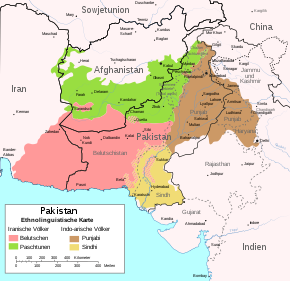Baluchistan conflict

The Baluchistan conflict is a conflict between the central governments of Pakistan and Iran and Baluch tribes since the independence of Pakistan.
causes
Despite the fact that the Baluch Province has deposits of gas, zinc, iron and copper, the province is poor. Pakistan is making major investments in Gwadar , which should serve the connection to Central Asia . The city is filling up with Pakistanis from other regions. There is a sense of dispossession.
The course of the conflict
In August 1947 Balochistan's declaration of independence took place, and both chambers of the Baloch parliament voted against a merger with Pakistan, which sought centralized rule over the relatively sparsely populated but mineral-rich area. In the period that followed, several wars broke out between Pakistan and the nationalists in Balochistan. First, on April 1, 1948, Pakistani soldiers marched into Balochistan and annexed the state.
In the years 1958–1969 there were further armed conflicts. 1973–1977 a total of 8,000 people died in the fighting. In 2004 the most violent conflict to date broke out. In 2006, the rebel leader Nawab Akbar Bugti was killed by Pakistani security forces.
Pakistan accuses India of funding 40 terrorist training camps in Balochistan.
Current situation
The 5th conflict, which continues to this day, began in 1994. The cause of the uprising of the Baluchistan Liberation Army, Baluchistan Liberation Front and People's Liberation Army is government policy. This conflict resulted in the killing of Chinese and a rocket attack on Gwadar airport . According to the Pakistan Army, the Balochistan Liberation Army is funded by the government of Afghanistan .
Individual evidence
- ↑ With cards open, Balochistan - Another Civil War? Broadcast on Arte on May 24, 2006 at 10:30 p.m.